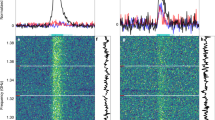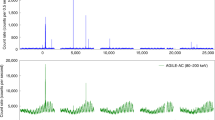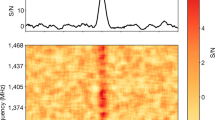Abstract
RECENT observations with the BATSE instrument on the Compton Gamma Ray Observatory show that the distribution of γ-ray bursts is isotropic but radially non-uniform1. Spectral features, time histories and the presence of X-ray tails suggest that the bursts arise from galactic neutron stars2, but low-velocity neutron stars born in the galactic disk would be concentrated towards the galactic plane3,4, which would not fit the BATSE results. Neutron stars born with velocities greater than ∼800 km s−1 will, however, escape from the Galaxy's gravitational field. We show here that a population of such objects can fit the γ-ray burst distributions found by BATSE and also the Pioneer Venus Orbiter5, although two important conditions must be met: the high-velocity neutron stars should turn on as burst sources only after some time (perhaps after they have ceased to be radiopulsars), and the low-velocity neutron stars must rarely generate γ-ray bursts. The observed correlation6–8 in pulsars between magnetic moment and velocity may provide a physical cause for the difference in bursting properties between the two populations. Our model implies that the brightest bursts, with fluxes ≳3 × 10−5 erg cm−2s−1, will be anisotropically distributed.
This is a preview of subscription content, access via your institution
Access options
Subscribe to this journal
Receive 51 print issues and online access
$199.00 per year
only $3.90 per issue
Buy this article
- Purchase on Springer Link
- Instant access to full article PDF
Prices may be subject to local taxes which are calculated during checkout
Similar content being viewed by others
References
Meegan, C. A. et al. Nature 355, 143–145 (1992).
Higdon, J. C. & Lingenfelter, R. E. A. Rev. Astr. Astrophys. 28, 401–436 (1990).
Dermer, C. D. & Hurley, K. C. Publ. astr. Soc. Pac. 103, 774–776 (1991).
Paczyński, B. Astrophys. J. 348, 485–494 (1990).
Chuang, K. W. et al. Astrophys. J. 391, 242–245 (1992).
Lyne, A. G., Anderson, B. & Salter, M. J. Mon. Not. R. astr. Soc. 201, 503–520 (1982).
Cordes, J. M. Astrophys. J. 311, 183–196 (1986).
Stollman, G. M. & van den Heuvel, E. P. J. Astr. Astrophys. 162, 87–94 (1986).
Liang, E. P. & Petrosian, V. (eds) Gamma Ray Bursts (AIP, New York, 1986).
Fomalont, E. B. et al. Mon. Not. R. astr. Soc. (in the press).
Harrison, P. A., Lyne, A. G. & Anderson, B. Mon. Not. R. astr. Soc. (in the press).
Frail, D. A. & Kulkarni, S. R. Nature 352, 785–787 (1991).
Bhattacharya, D. et al. Astr. Astrophys. 254, 198–212 (1992).
Michel, F. C. Theory of Neutron Star Magnetospheres (Univ. Of Chicago, London, 1990).
Shklovskii, I. S. & Mitrofanov, I. G. Mon. Not. R. astr. Soc. 212, 545–551 (1985).
Dermer, C. D. & Li, H. in Huntsville Workshop on Gamma-Ray Bursts (eds Paciesas, W. & Fishman, G.) (AIP, in the press).
Harwit, M. Astrophysical Concepts (Springer, New York, 1988).
Tully, R. B. & Fisher, J. R. Nearby Galaxies Catalog (Cambridge Univ. Press, New York, 1987).
Meegan, C. A. et al. IAU Telegram No. 5478 (18 March 1992).
Duncan, R. C. & Thompson, C. Astrophys J. 392, L9–L13 (1992).
Bailes, M. Astrophys. J. 342, 917–927 (1989).
Salvati, M. & Pacini, F. in The Origin and Evolution of Neutron Stars (eds Helfand, D. J. & Huang, J.-H.) 79–89 (Reidel, Dordrecht, 1987).
BATSE News Service BNEWS Report (12 February 1992).
Fenimore, E. E. et al. Nature 357, 140–141 (1992).
Hartmann, D. & Epstein, R. I. Astrophys. J. 346, 960–966 (1989).
Higdon, J. C. & Schmidt, M. Astrophys. J. 355, 13–17 (1990).
Liang, E. P. Astrophys. J. 380, L55–L58 (1991).
Liang, E. P. in Gamma Ray Line Astrophysics (eds Durouchoux, P. & Prantzos, N.) 380–394 (AIP, New York, 1991).
Lingenfelter, R. E. & Higdon, J. C. Nature 356, 132–133 (1992).
Brainerd, J. J. Nature 355, 522–524 (1992).
Paczyński, B. Acta astr. 41, 157–167 (1991).
Author information
Authors and Affiliations
Rights and permissions
About this article
Cite this article
Li, H., Dermer, C. Gamma-ray bursts from high-velocity neutron stars. Nature 359, 514–516 (1992). https://doi.org/10.1038/359514a0
Received:
Accepted:
Issue Date:
DOI: https://doi.org/10.1038/359514a0
This article is cited by
-
Evidence from a processing pulsar orbit for a neutron-star birth kick
Nature (1996)
-
High velocity neutron stars and ?-ray bursts
Astrophysics and Space Science (1996)
-
Are galactic GRB models still an option?
Astrophysics and Space Science (1995)
-
Gamma-ray bursts from high velocity neutron stars
Astrophysics and Space Science (1995)
-
Cosmological models of gamma-ray bursts
Astrophysics and Space Science (1995)
Comments
By submitting a comment you agree to abide by our Terms and Community Guidelines. If you find something abusive or that does not comply with our terms or guidelines please flag it as inappropriate.



